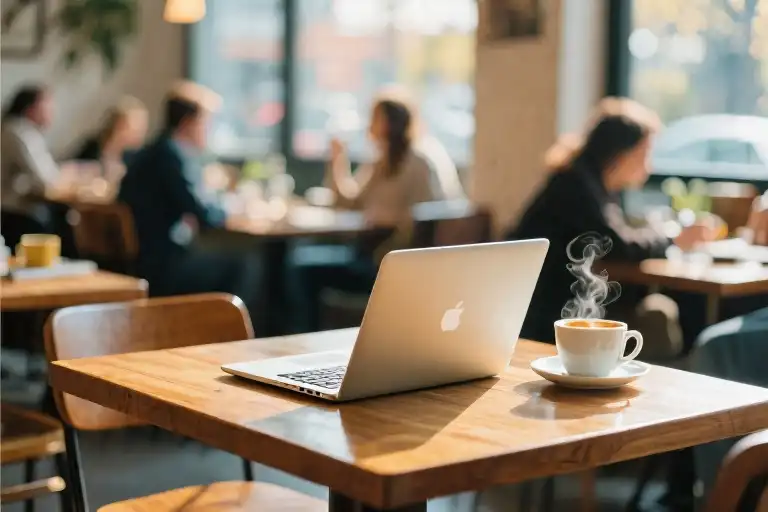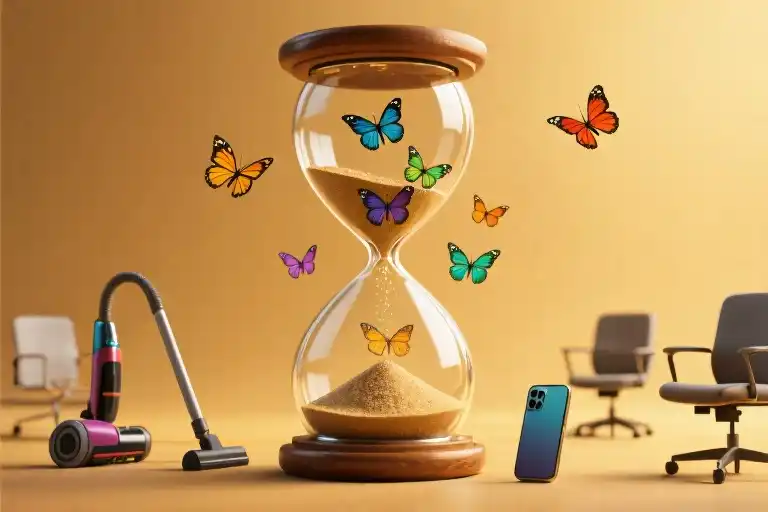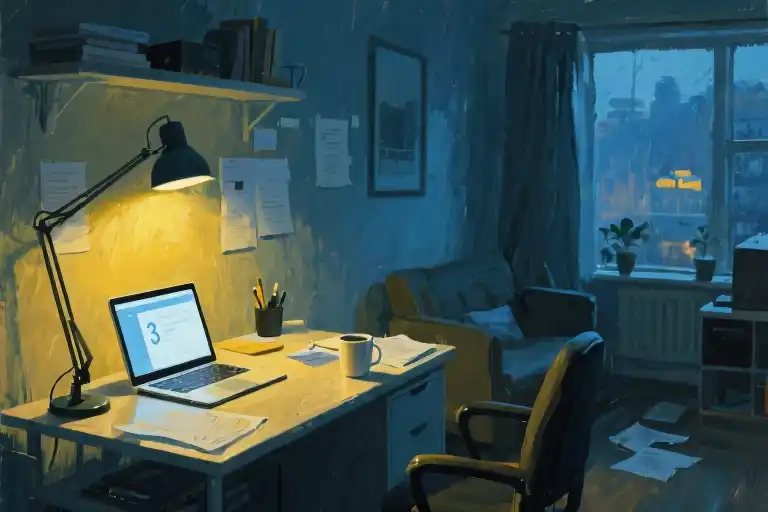The steam from the espresso machine curled through the air as my friend tapped away on his laptop, completely absorbed in his design work. Around us, the café hummed with quiet conversations and the occasional clink of porcelain. Meanwhile, I’d just come from another frustrating morning in my meticulously designed home office – the Herman Miller chair, noise-canceling headphones, and dual 4K monitors doing little to prevent my usual three-hour procrastination ritual before tackling actual work.
‘Dude,’ I finally blurted out between sips of my overpriced latte, ‘you work for yourself. No boss. No office politics. Complete freedom to work anywhere.’ I gestured at our wobbly table where his MacBook balanced precariously near a coffee ring stain. ‘Why choose this over your amazing apartment setup?’
He smiled that infuriatingly calm smile of his – the one I’d seen countless times when we compared our freelance lifestyles. His apartment truly was a productivity fantasy: that ergonomic chair collectors would kill for, the perfect lighting setup, even one of those fancy sit-stand desks. Yet here he was, surrounded by chattering strangers and the hiss of milk frothers, somehow accomplishing more before noon than I did all day.
‘Because I actually get work done here,’ he said simply, as if explaining why the sky was blue.
Recent surveys show 72% of freelancers regularly work outside their homes, with cafés being the most popular alternative. Yet most productivity advice still focuses on creating the ‘perfect’ home office. There’s an unspoken assumption that professional-grade equipment equals professional-grade output. My friend’s daily café habit – and his consistent high-quality work – suggested something far more interesting about how environment shapes productivity.
The jazz playlist transitioned to something with a stronger bassline as I studied our surroundings anew. The barista remembered my friend’s usual order. The couple nearby debated screenplay ideas. The sunlight made patterns through the front windows. None of this matched the conventional wisdom about ‘distraction-free workspaces,’ yet my friend’s focused expression told its own story. Somewhere in this apparent contradiction lay insights that could reshape how remote workers approach their daily environments.
The Freelancer’s Space Paradox: When Perfect Setup Fails
My friend’s apartment workspace could easily grace the cover of Remote Work Digest. A sprawling L-shaped desk anchored by dual 32-inch 4K monitors, the kind that make color-sensitive designers weep with joy. The pièce de résistance? That limited-edition Herman Miller Embody chair – the one with synchronized spine support that costs more than my monthly rent. Yet every morning, he abandons this ergonomic paradise for a corner table at our local café, where the third chair perpetually wobbles like a newborn giraffe.
Meanwhile, my own home office setup – complete with noise-canceling headphones and a meticulously organized bullet journal – becomes ground zero for what I’ve dubbed “productive procrastination.” There’s always
The Café’s Hidden Alchemy
What makes this caffeine-scented chaos so magnetizing for freelancers? The answer lies in three psychological undercurrents:
- The Goldilocks Noise Principle
That steady hum of espresso machines (around 70dB, per Journal of Consumer Research) creates the ideal “cognitive cocktail” – enough ambient sound to prevent over-focus fatigue, but insufficient to derail deep work. It’s the acoustic sweet spot between a library’s silence and an open-office din. - Passive Social Scaffolding
Unlike home isolation where distractions feel like personal failures, café interruptions come pre-packaged as communal experiences. The barista’s laugh, a neighboring laptop’s keyboard clicks – these become unconscious accountability partners. University of Chicago researchers call this “ambient sociability,” proving even minimal social presence boosts task persistence by 23%. - Ritual Reinforcement
The simple act of packing a work bag signals to our brains: This is work mode. Like athletes putting on uniforms, freelancers subconsciously adopt professional mindsets when entering third spaces. My friend describes it as “flipping an invisible productivity switch” that home environments often lack.
When Tables Turn Literally
Back at the café, I finally understood why my friend’s MacBook sat perfectly steady despite the table’s uneven leg. He’d wedged a folded napkin under one corner – a tactile reminder that productivity isn’t about flawless conditions, but about crafting environments that work with our psychology rather than against it. The real luxury wasn’t in his apartment’s tech specs, but in the freedom to choose the space where his mind thrived.
The Hidden Advantages of Coffee Shop Work
My friend took another sip of his cappuccino before explaining what seemed like a paradox. “Because I actually get work done here.” The simplicity of his answer masked layers of psychological wisdom that most freelancers overlook in their quest for the perfect home office.
The Goldilocks Zone of Noise
Research from the University of Chicago suggests why that buzzing coffee machine might be helping rather than hindering. Their study on ambient noise and cognitive performance reveals that moderate noise levels (around 70 decibels – typical for cafés) create just enough distraction to boost creativity by 15% compared to silent environments. This phenomenon follows the inverted-U curve principle: complete silence can be as distracting as loud chaos, while the gentle hum of a café hits the sweet spot for focus.
“At home,” my friend continued, “the refrigerator humming or neighbor’s dog barking feels like an intrusion. But here, the clinking cups and espresso machine become white noise that somehow signals my brain it’s work time.”
The Unseen Colleagues Effect
What psychologists call “social presence” explains another hidden benefit. Unlike the isolating silence of a home office, cafés provide passive social interaction – the awareness of others working around you without direct engagement. A Journal of Experimental Social Psychology study found this subtle social context reduces procrastination by creating gentle accountability, as if the surrounding patrons become silent coworkers.
“When I see someone across the room typing furiously,” my friend noted, “it triggers my own productive energy more than any productivity app ever could.”
Ritual Over Resources
The most counterintuitive insight emerged when he described his morning routine: “Walking to the café with my laptop bag functions like an old-school commute. Ordering my usual drink marks the official start of work hours. These tiny rituals create psychological boundaries that my fancy home office setup somehow fails to establish.”
Neuroscience supports this – environmental cues (like specific smells or background sounds) create powerful mental associations. The café becomes a dedicated “work container” where the brain automatically shifts into focus mode, while home spaces carry mixed associations with relaxation and chores.
The Freedom Paradox
This reveals the fundamental misunderstanding many freelancers have about workplace freedom. True productivity freedom isn’t about working anywhere, but about strategically choosing environments that provide the right constraints. As my friend put it while packing up: “The café gives me just enough structure to make my freedom meaningful.”
Finding Your Optimal Workspace: From Coffee Shops to Alternative Spaces
The Creative Workspace Formula
For freelancers handling creative tasks like design, writing, or conceptual work, environmental stimulation becomes your invisible collaborator. Research from the University of Illinois suggests moderate ambient noise (around 70 decibels – typical café level) enhances creative cognition by 15%. This explains why:
- Dynamic visual input from passersby subconsciously triggers novel neural connections
- Barista chatter and espresso machine rhythms create that perfect ‘productive murmur’
- The absence of domestic distractions (laundry, fridge, pets) preserves mental bandwidth
Pro Tip: Look for cafes with:
- Varied seating zones (window bars for people-watching, quiet corners for deep thinking)
- Natural light sources (proven to boost serotonin and focus)
- Mid-tempo instrumental playlists (avoid lyric-heavy music during verbal tasks)
The Execution Workspace Checklist
When tackling administrative tasks, coding marathons, or detail-oriented work, shift to environments mimicking traditional office conditions:
- Acoustic control: Libraries or coworking silent pods (below 50 decibels)
- Posture support: Adjustable-height tables with 90-degree elbow positioning
- Visual consistency: Monochrome decor minimizes cognitive load (avoid visually ‘busy’ spaces)
Hidden Gem: Many public libraries now offer free reservable work booths with:
- Power outlets every 30 inches
- Adjustable LED task lighting
- Soundproofing equivalent to WeWork private offices
The 5-Point Café Selection Matrix
Not all cafes are created equal for remote work. Use this field-tested evaluation system:
- Power Accessibility (3+ accessible outlets per 10 seats)
- Seat Stability (wobbly tables = productivity killer)
- Traffic Flow (ideal: 15-20 customers/hour – enough energy without overcrowding)
- Beverage Policy (friendly refill options beat expensive single purchases)
- Staff Attitude (observing how long laptops are tolerated during peak hours)
Alternative Spaces Worth Exploring:
- Museum member lounges (often empty on weekdays)
- Hotel lobbies with work nooks (free if you order coffee)
- University student centers (non-students welcome during summer)
Personalizing Your Environment Strategy
Your ideal workspace should align with both your work type and chronobiology. Track your energy patterns for 3 days:
| Time Slot | Task Type | Successful Environment |
|---|---|---|
| 9-11 AM | Creative Brainstorm | Bustling downtown café |
| 2-4 PM | Client Reports | Library study carrel |
| 7-9 PM | Email Triaging | Home standing desk |
Remember: The most expensive setup isn’t necessarily the most effective. As my designer friend concluded: “My $1,500 office chair collects dust while a $3 latte buys me eight productive hours.”
Where’s Your Productivity Sweet Spot?
The jazz playlist has looped twice, your third latte sits half-finished, and somehow you’ve crossed off every item on today’s to-do list. This wasn’t supposed to happen at a crowded café with wobbly tables, not when your home office boasts that $1,200 ergonomic throne. Yet here we are – another paradox of freelance productivity.
My designer friend leans back, surveying the café crowd with the satisfaction of someone who cracked the code. “These people,” he gestures to students sketching in notebooks and entrepreneurs typing furiously, “they’re my invisible coworkers.” The revelation lands differently after understanding how café environments create the perfect productivity cocktail: enough background chatter to feel connected but not obligated to engage, just-right ambient noise to drown out mental static, and that unspoken collective focus humming through the space.
The Unexpected Psychology Behind Workspace Choices
Research from the University of Illinois echoes what freelancers instinctively know – moderate ambient noise (around 70 decibels, typical for cafés) enhances creative cognition by about 15%. But the magic extends beyond acoustics:
- Environmental Anchoring
Switching locations triggers our brain’s “work mode” far more effectively than rolling from bed to desk. The commute—even just a 10-minute walk—builds crucial mental segmentation. - Social Scaffolding
Unlike home isolation, cafés provide passive social presence. Observing others working creates positive peer pressure, while brief, meaningless interactions (“Mind if I borrow the outlet?”) satisfy human connection needs without derailing focus. - Controlled Distractions
The gentle rhythm of coffee machines and occasional laughter creates what psychologists call “attention residue”—enough stimulation to prevent mind-wandering but not enough to disrupt deep work.
Crafting Your Personal Productivity Map
Your ideal workspace depends on task type:
| Work Mode | Environment Cues | Café Alternatives |
|---|---|---|
| Creative Flow | Medium noise (70dB), movement, natural light | Botanical gardens, museum cafés |
| Analytical Tasks | Low-interruption zones, stable seating | Library study rooms, co-working “silent pods” |
| Administrative Work | Background music, visual privacy | Hotel lobbies, bookstore reading areas |
Pro tip: Scout locations mid-morning when the work crowd reveals a spot’s true productivity potential. Look for power outlets camouflaged in floorboards and staff who won’t side-eye your four-hour laptop tenure.
“So where does your brain work best?” My friend tosses the question back as we pack up. Maybe it’s the corner booth at your local indie café, a park bench with stellar WiFi, or that perfect nook in the public library. The freedom to choose is your superpower—the trick is discovering which environments choose you back.
Drop your unexpected productivity haven in the comments—we’re compiling the ultimate offbeat workspace guide (best submissions earn coffee credits!). Meanwhile, I’ll be at the café counter ordering what my barista already knows is “the usual.”





